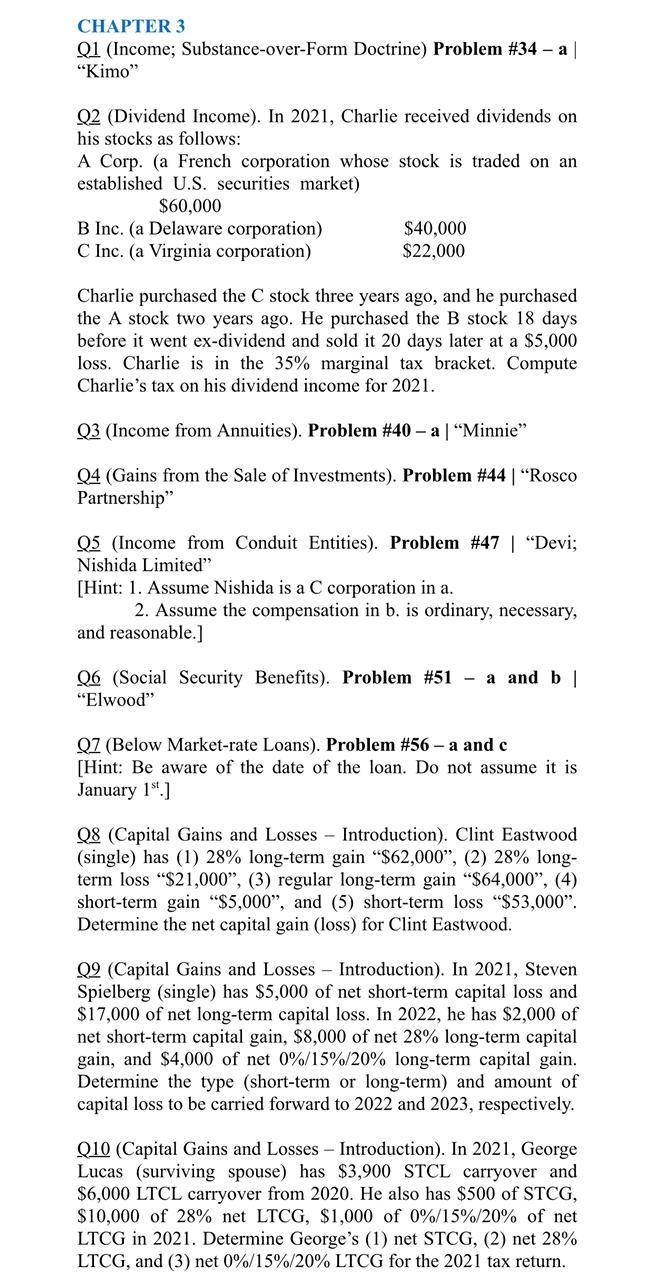QUESTION-02,8,9 QUESTION-2,8,9,10
QUESTION-2,8,9,10
CHAPTER 3 01 (Income; Substance-over-Form Doctrine) Problem #34 - a "Kimo" Q2 (Dividend Income). In 2021, Charlie received dividends on his stocks as follows: A Corp. (a French corporation whose stock is traded on an established U.S. securities market) $60,000 B Inc. (a Delaware corporation) $40,000 C Inc. (a Virginia corporation) $22,000 Charlie purchased the stock three years ago, and he purchased the A stock two years ago. He purchased the B stock 18 days before it went ex-dividend and sold it 20 days later at a $5,000 loss. Charlie is in the 35% marginal tax bracket. Compute Charlie's tax on his dividend income for 2021. Q3 (Income from Annuities). Problem #40 - a "Minnie" Q4 (Gains from the Sale of Investments). Problem #44 | "Rosco Partnership" Q5 (Income from Conduit Entities). Problem #47 | Devi; Nishida Limited" [Hint: 1. Assume Nishida is a C corporation in a. 2. Assume the compensation in b. is ordinary, necessary, and reasonable.] 26 (Social Security Benefits). Problem #51 - a and b | "Elwood" Q7 (Below Market-rate Loans). Problem #56-a and c [Hint: Be aware of the date of the loan. Do not assume it is January 15.] Q8 (Capital Gains and Losses - Introduction). Clint Eastwood (single) has (1) 28% long-term gain "$62,000", (2) 28% long- term loss "$21,000, (3) regular long-term gain $64,000", (4) short-term gain "$5,000", and (5) short-term loss "$53,000". Determine the net capital gain (loss) for Clint Eastwood. 09 (Capital Gains and Losses - Introduction). In 2021, Steven Spielberg (single) has $5,000 of net short-term capital loss and $17,000 of net long-term capital loss. In 2022, he has $2,000 of net short-term capital gain, $8,000 of net 28% long-term capital gain, and $4,000 of net 0%/15%/20% long-term capital gain. Determine the type (short-term or long-term) and amount of capital loss to be carried forward to 2022 and 2023, respectively. Q10 (Capital Gains and Losses - Introduction). In 2021, George Lucas (surviving spouse) has $3,900 STCL carryover and $6,000 LTCL carryover from 2020. He also has $500 of STCG, $10,000 of 28% net LTCG, $1,000 of 0%/15%/20% of net LTCG in 2021. Determine George's (1) net STCG, (2) net 28% LTCG, and (3) net 0%/15%/20% LTCG for the 2021 tax return. CHAPTER 3 01 (Income; Substance-over-Form Doctrine) Problem #34 - a "Kimo" Q2 (Dividend Income). In 2021, Charlie received dividends on his stocks as follows: A Corp. (a French corporation whose stock is traded on an established U.S. securities market) $60,000 B Inc. (a Delaware corporation) $40,000 C Inc. (a Virginia corporation) $22,000 Charlie purchased the stock three years ago, and he purchased the A stock two years ago. He purchased the B stock 18 days before it went ex-dividend and sold it 20 days later at a $5,000 loss. Charlie is in the 35% marginal tax bracket. Compute Charlie's tax on his dividend income for 2021. Q3 (Income from Annuities). Problem #40 - a "Minnie" Q4 (Gains from the Sale of Investments). Problem #44 | "Rosco Partnership" Q5 (Income from Conduit Entities). Problem #47 | Devi; Nishida Limited" [Hint: 1. Assume Nishida is a C corporation in a. 2. Assume the compensation in b. is ordinary, necessary, and reasonable.] 26 (Social Security Benefits). Problem #51 - a and b | "Elwood" Q7 (Below Market-rate Loans). Problem #56-a and c [Hint: Be aware of the date of the loan. Do not assume it is January 15.] Q8 (Capital Gains and Losses - Introduction). Clint Eastwood (single) has (1) 28% long-term gain "$62,000", (2) 28% long- term loss "$21,000, (3) regular long-term gain $64,000", (4) short-term gain "$5,000", and (5) short-term loss "$53,000". Determine the net capital gain (loss) for Clint Eastwood. 09 (Capital Gains and Losses - Introduction). In 2021, Steven Spielberg (single) has $5,000 of net short-term capital loss and $17,000 of net long-term capital loss. In 2022, he has $2,000 of net short-term capital gain, $8,000 of net 28% long-term capital gain, and $4,000 of net 0%/15%/20% long-term capital gain. Determine the type (short-term or long-term) and amount of capital loss to be carried forward to 2022 and 2023, respectively. Q10 (Capital Gains and Losses - Introduction). In 2021, George Lucas (surviving spouse) has $3,900 STCL carryover and $6,000 LTCL carryover from 2020. He also has $500 of STCG, $10,000 of 28% net LTCG, $1,000 of 0%/15%/20% of net LTCG in 2021. Determine George's (1) net STCG, (2) net 28% LTCG, and (3) net 0%/15%/20% LTCG for the 2021 tax return
 QUESTION-2,8,9,10
QUESTION-2,8,9,10





